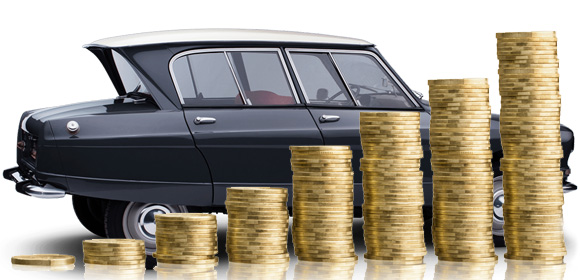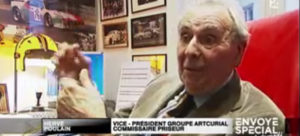by Herns Pierre-Jerome…..
I came across this interesting French video about the prospects of the old car market. Even if you won’t be able to understand the entire content, the title “rust at the price of gold” and some of the pictures are quite appealing.
Many of the old rusty cars shown were owned by Roger Baillon and went for auction with huge prices paid at Retrombile in 2016. (Covered in this Citroenvie article: https://citroenvie.com/have-a-look-at-what-french-rust-is-going-for-nowadays/).
Besides the highly rare and expensive oldies, there are some Citroëns, like an Ami 6, that retain attention. (Further details in this Citroënvie article: https://citroenvie.com/ami-6-berline-commands-record-price-at-auction/).
From watching the Envoyé Spécial video, I ended up with some intriguing questions relating to the rush for, restoration and auction of antique cars.
Let’s start with a summary of that video and the major ideas expressed therein. The history of and outcomes of Roger Baillon collection’s auction has been a starting point for an in-depth presentation of the old car market in France.
Not much has been added to what was outlined on the Citroenvie report relating to the Baillon Collection’s auction except for an overview of circumstances that allowed for the auctioneers to know about, explore and move what was left of Roger Baillon’s car collection. At different stages of that venture, the two car scavengers and auctioneers (Matthieu Lamoure and Pierre Nelikoff) and their business associates at Auctioneers Artcurial, Hervé Poulain (a former race car pilot) developed their views on worldwide renewed interest in, search for and prospects for investments in old cars.
Interviews with other old car collectors and tours of their collections were used by “Envoyé Spécial” to support or supplement those car specialists’ views.
According to antique car collectors and specialists interviewed in that program, it is important to develop contacts in faraway corners of France and be available and ready to rush wherever there is a treasure trove. Risk-taking is an essential part of success in the old car business, for there is always a possibility to earn big money even on a wreck. Some old cars have a history behind them and are rather rare, either because of whom they previously belonged to or for their uniqueness and their specificities. Profit-wise, those are the most desirable investment opportunities. Worldwide collectors are active in their quest for old cars in various shapes and models. Therefore, purchasing old cars is a sound investment compared to bank placements in the nowadays world of currency fluctuations.
Sharing some of those views is an antique car collector named Laurent Laplace. A nurseryman by trade, this gentleman shelters his collection of forty old French cars in a discrete storage compartment located behind his nursery business. Those are old Citroens, Talbots, Delahayes, Delages and so on. In his outline of motives, circumstances, and objectives behind collecting so many old cars, he was rather vague about the investment aspect of collecting antique automobiles. For him, it is a passion more than anything else; it is a reflection of his love for old and rare models. His cars are part of his family and have been kept in perfect shape for the pleasure they offer family members, he commented. He insisted that all his cars are for personal use and not for sale however high the offers he may receive for them. They are purchased whenever opportunities come up but with no speculation intent or goal. As an example, the oldest car of his collection, a 1930 Citroen was purchased for 7000 Francs, the equivalent of €1000.00, and is now worth what the highest bidder at an auction would be willing to pay to acquire such a jewel.
Sitting next to Monsieur Laplace at the auction was Christopher Garner, a rich American collector of oldies, who lives near Geneva. A conversation during a visit to his four decades old car collection offered some new insights into old car collector’s perception of how to increase profitability in collecting old cars. For this collector, there is no value in holding on to the same cars or keeping a lot of ordinary classic cars for number’s sake. To increase investment profitability, it is absolutely necessary to resell cars of lesser value and purchase highly rare or prestigious models. Some of his cars are already in the last category and will, therefore, remain forever part of the collection. A case in point is a gull-wing door Mercedes he purchased for €7000.00 and is now worth more than 1 million. Others are less likely to be considered worth keeping because they reach their peak value at a given moment. This is the case for a 1930 Alpha Romeo that Christopher Garner purchased for €65.000 and considered worth €1.450.000 after owning it for 15 years. Unable to obtain that ceiling price at Hervé Poulain’s auction, Garner let his Alpha Romeo go on a €1,030.000 bid. He stressed his love of the car while considering there cannot be better investment return than that auction outcome. And so, having bought 100 antique cars over a 45 year collection period, he holds on to 20 high-value cars only.
At the auction for the remaining cars of the Baillon Collection, worth noting were a 1959 Talbot T26 that was specially built by prestigious French coachbuilder Jacques Saroutchik and previously owned by Egypt’s Royal Family of King Farouk, and also a Ferrari 250 California that belonged to actor Alain Delon and that was thought to be destroyed. Because those two cars belonged to celebrities, they were thought to be in better position to attract higher bids at auction than other oldies. Auctioneers often use this as a reason to publicize as much information about a car’s history. As Lamoure expressed it “Picture of Alain Delon at the wheel will suffice to raise passion”. Being a rare model with a prestigious history, Delon’s Ferrari 250 California fetched a ludicrous sum of €16.200.000 and was picked up by an American collector.
Of course, the picture is not always rosy in the acquisition and resale of antique cars, particularly at auction. There are instances when a long-time collector with experience at bidding lost a car he dearly sought to acquire. It does happen that a less sophisticated buyer bid an excessive amount well above the value the experienced collector realistically set for that car. Losing an auction a bidder wants to win is rarely a pleasant experience as demonstrated by the two cases that follow. Laurent Laplace inspected a rusted Talbot with a mechanic friend and planned to bid in the €2000 range to purchase it. He hoped that the outcome would be close to that amount. But, as the auction progressed, he became disillusioned. After all, that car fetched an unthinkable €20,000.00, ten times what he was willing to pay for it.”
Various techniques have been used by auctioneers and collectors to push up old car’s prices. At some point, small collectors, mostly younger car amateurs, were unable to compete for those 1930 to 1950 high-value antiques. Those younger collectors developed their own niche with post-1960 popular autos. As older collectors drive their high-value oldies across Paris twice a year to make them visible, those younger car amateurs show and trade their more recent cars on neighborhood parking lots. Charles Bonin, a 25 year old car amateur belongs to the new generation of antique collectors. Like others of his collector group, he purchased a Peugeot 204, a most popular car of the 1960s. He undertook its restoration with the hope of increasing its value over time.
Among questions that may be asked are the following:
• How long will the rush for antique cars last?
• Is the rush for antique cars nothing but a speculation bubble?
• Is it worth selling lesser valued antique cars to purchase highest level ones?
• Shall cheaper more recent and more popular cars bought at an affordable price from private sellers be preferred to more expensive ones as a group of younger collectors claimed?
• Is it worth taking risks purchasing cars that necessitate costly restorations?
• Is it worth scavenging, unearthing classic barn cars and undertake their restoration?
• What will be the fate of collections owners have held on to after those owners have passed on?
For “rust” to remain “gold” requires a willingness from old car’s collectors to acquire those oldies at whatever prices bidding competitions may reach. This, in turn, requires that those cars remain desirable goods, popular or prestigious possessions, real or perceived as such. Keeping public interest in oldies implies a certain level of visibility. Auctions of old car collections, outings involving as many as 500 old cars in Paris twice a year and gatherings of less prestigious but popular models in some corners on a Sunday are the kind of attractive presence likely to maintain interest in old cars.


